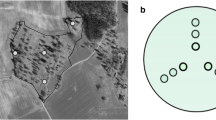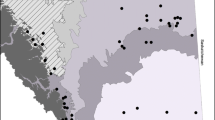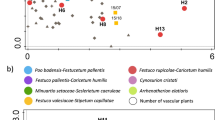Abstract
Restoration of semi-natural grasslands by cattle grazing is among the most practical options for reversing the decline of northern European floristic diversity, but no studies on this subject are available. In this work the success of restoration of abandoned, privately owned mesic semi-natural grasslands by farmers receiving support from the EU agri-environmental support scheme was studied in southwestern Finland. Three kinds of grasslands were compared: old (continuously cattle grazed), new (cattle grazing restarted 3–8 years ago) and abandoned pastures (grazing terminated >10 years ago). Plant species composition of the three pasture types was floristically different in multivariate analyses (non-metric multidimensional scaling). Total species richness, richness of grassland plants, indicator plants and rare plants were highest in old and lowest in abandoned pastures in all studied spatial scales (0.25–0.8 ha, 1 and 0.01 m2). The results were congruent with different scales and species list definitions, suggesting that species density scale (1 m2) can be used as a partial surrogate for large scale species richness. Species richness of new pastures was 20% higher on 0.25–0.8 ha, 40–50% higher on 1 m2 and 30% higher on the 0.01 m2 scale compared to abandoned grasslands. Rare species showed insignificant response to resumed grazing. Despite problems in management quality, this study showed promising results of restoration of abandoned grasslands by cattle grazing on private farms. However, populations of several rare grassland plants may not recover with present cattle grazing regimes. Management regulations in the agri-environmental support scheme need to be defined more precisely for successful restoration.
Similar content being viewed by others
References
Austad I. and Losvik M.H. 1998. Changes in species composition following field and tree layer restoration and management in a wooded hay meadow. Nordic Journal of Botany 18: 641–662.
Austad I. and Skogen A. 1990. Restoration of a deciduous woodland in Western Norway formerly used for fodder production: effects on tree canopy and field layer. Vegetatio 88: 1–20.
Austrheim G. and Olsson E.G.A. 1999. How does continuity in grassland management after ploughing affect plant community patterns? Plant Ecology 145: 59–74.
Bakker J.P. 1989. Nature Management by Grazing and Cutting. Kluwer, Dordrecht, The Netherlands.
Bakker J.P. 1998. The impact of grazing to plant communities. In: Wallis DeVries M.F., Bakker J.P. and Van Wieren S.E. (eds), Grazing and Conservation Management. Kluwer, Dordrecht, The Netherlands, pp. 137–184.
Bakker J.P. and Berendse F. 1999. Constraints in the restoration of ecological diversity in grassland and heathland communities. Trends in Ecology and Evolution 14: 63–68.
Bakker J.P., Bakker E.S., Rosén E., Verweij G.L. and Bekker R.M. 1996. Soil seed bank composition along a gradient from dry alvar grassland to Juniperus shrubland. Journal of Vegetation Science 7: 165–176.
Barbaro L., Dutoit T. and Cozic P. 2001. A six-year experimental restoration of biodiversity by shrub-clearing and grazing in calcareous grasslands of the French Prealps. Biodiversity and Conservation 10: 119–135.
Beaufoy G., Baldock D. and Clark J. 1994. The Nature of Farming. Low Intensity Farming Systems in Nine European Countries. The Institute of European Environmental Policy, London.
Bekker R.M., Verweij G.L., Smith R.E.N., Reine R., Bakker J.P. and Schneider S. 1997. Soil seed banks in European grasslands: does land use affect regeneration perspectives? Journal of Applied Ecology 34: 1293–1310.
Berendse F., Oomes M.J.M., Altena H.J. and Elberse W.Th. 1992. Experiments on the restoration of species-rich meadows in The Netherlands. Biological Conservation 62: 59–65.
Bignal E.M. and McCracken D.I. 1996. Low-intensity farming systems in the conservation of the countryside. Journal of Applied Ecology 33: 413–424.
Bobbink R. and Willems J.H. 1987. Increasing dominance of Brachypodium pinnatum (L.) Beauv. in chalk grasslands: a threat to a species-rich ecosystem. Biological Conservation 40: 301–314.
Bobbink R. and Willems J.H. 1993. Restoration management of abandoned chalk grassland in The Netherlands. Biodiversity and Conservation 2: 616–626.
Chaneton E.J. and Facelli J.M. 1991. Disturbance effects on plant community diversity: spatial scales and dominance hierarchies. Vegetatio 93: 143–155.
Dolek M. and Geyer A. 2002. Conserving biodiversity on calcareous grasslands in the Franconian Jura by grazing: a comprehensive approach. Biological Conservation 104: 351–360.
European Environment Agency 1999. Environment in the European Union at the Turn of the Century. EEA, Copenhagen, Denmark.
Gibson C.W.D. 1986. Management history in relation to changes in the flora of different habitats on an Oxfordshire Estate, England. Biological Conservation 38: 217–232.
Gibson C.W.D. and Brown V.K. 1991. The nature and rate of development of calcareous grassland in Southern Britain. Biological Conservation 58: 297–316.
Gibson C.W.D. and Brown V.K. 1992. Grazing and vegetation change: deflected or modified succession? Journal of Applied Ecology 29: 120–131.
Grime J.P., Hodgson J.G. and Hunt R. 1988. The Comparative Plant Ecology. Unwin Hyman, London.
Hald A.B. and Vinther E. 2000. Restoration of a species-rich fen-meadow after abandonment: response of 64 plant species to management. Applied Vegetation Science 3: 15–24.
Hämet-Ahti L., Suominen J., Ulvinen T. and Uotila P. (eds) 1998. Field Flora of Finland. 4th edn. Finnish Museum of Natural History, Botanical Museum, Helsinki, Finland (in Finnish).
Hillier S.H., Walton D.W.H. and Wells D.A. (eds) 1990. Calcareous Grasslands ¶ Ecology and Management. Bluntisham Books, Bluntisham, UK.
Huhta A.-P., Rautio P., Tuomi J. and Laine K. 2001. Restorative mowing on an abandoned semi-natural meadow: short-term and predicted long-term effects. Journal of Vegetation Science 12: 677–686.
Janssens F., Peeters A., Tallowin J.R.B., Bakker J.P., Bekker R.M., Fillat F. et al. 1998. Relationship between soil chemical factors and grassland diversity. Plant and Soil 202: 69–78.
Johansson O. and Hedin P. 1991. Restaurering av ängs-och hagmarker. Naturvårdsverket, Solna, Sweden (in Swedish).
Klötzli F. and Gootjans Ab.P. 2001. Restoration of natural and semi-natural wetland systems in Central Europe: progress and predictability of developments. Restoration Ecology 9: 209–219.
Kontula T., Lehtomaa L. and Pykälä J. 2000. Land-use history, vegetation and flora in Rekijoki valley, Somero, SW Finland. Suomen ympäristö 306(in Finnish with an English summary): 1–91.
Kotiluoto R. 1998. Vegetation changes in restored semi-natural meadows in the Turku Archipelago of SW Finland. Plant Ecology 136: 53–67.
Krebs J.R., Wilson J.D., Bradbury R.B. and Siriwardena G.M. 1999. The second Silent Spring? Nature 400: 611–612.
Losvik M.H. 1992. Restoring abandoned pasture by mowing ¶ influences on frequency and cover of plant species. Norwegian Journal of Agricultural Sciences 6: 391–409.
McCune B. and Mefford B.J. 1999. PC-ORD. Multivariate Analysis of Ecological Data, version 4. MjM Software Design, Gleneden Beach,Oregon.
Marss R.H. 1993. Soil fertility and nature conservation in Europe: theoretical considerations and practical management solutions. Advances in Ecological Research 24: 241–300.
Mitlacher K., Poschlod P., Rosén E. and Bakker J.P. 2002. Restoration of wooded meadows ¶ a comparative analysis along a chronosequence on Öland (Sweden). Applied Vegetation Science 5: 63–73.
Mortimer S.R., Hollier J.A. and Brown V.K. 1998. Interactions between plant and insect diversity in the restoration of lowland calcareous grasslands in southern Britain. Applied Vegetation Science 1: 101–114.
Olff H. and Ritchie M.E. 1998. Effects of herbivores on grassland plant diversity. Trends in Ecology and Evolution 13: 261–265.
Ovenden G.N., Swash A.R.H. and Smallshire D. 1998. Agri-environment schemes and their contribution to the conservation of biodiversity in England. Journal of Applied Ecology 35: 955–960.
Persson S. 1984.Vegetation development after the exclusion of grazing cattle in a meadow area in the south of Sweden. Vegetatio 55: 65–92.
Poschlod P., Kiefer S., Tränkle U., Fischer S.F. and Bonn S. 1998. Plant species richness in calcareous grasslands as affected by dispersability in space and time. Applied Vegetation Science 1: 75–90.
Pykälä J. 1998. 100 or 200 archaeophytes in the flora of Finland? Lutukka 14 (in Finnish with an English summary): 35–57.
Pykälä J. 2000. Mitigating human effects on European biodiversity through traditional animal husbandry. Conservation Biology 14: 705–712.
Pykälä J. 2001. Maintaining biodiversity through traditional animal husbandry. The Finnish Environment 495 (in Finnish with an English summary): 1–202.
Salminen P. and Kekäläinen H. 2000. The management of agricultural heritage habitats in Finland. Report by the Heritage Landscapes Working Group. The Finnish Environment 443 (in Finnish with an English summary): 1–161.
Schalitz G., Scholz A. and Masch E. 1995. Extensive Beweidung von Niedermooren für die Ziele eines integrierten Naturschutzes. Zeitschrift für Kulturtechnik und Landentwicklung 36: 117–121.
Scholz A. 1995.Vom Weidevieh gemiedene Pflanzen, Ausbreitung und Massnahmen zur Eindämmung. Zeitschrift für Kulturtechnik und Landentwicklung 36: 173–174.
Smith R.S., Shiel R.S., Millward D. and Corkhill P. 2000. The interactive effects of management on the productivity and plant community structure of an upland meadow: an 8-year field trial. Journal of Applied Ecology 37: 1029–1043.
Stampfli A. and Zeiter M. 1999. Plant species decline due to abandonment of meadows cannot easily be reversed by mowing. A case study from the southern Alps. Journal of Vegetation Science 10: 151–164.
Sutherland W.J. 2002. Restoring a sustainable countryside. Trends in Ecology and Evolution 17: 148–150.
Vestergaard P. 1985. Effects of mowing on the composition of Baltic salt-meadow communities. Preliminary results. Vegetatio 62: 383–390.
Vestergaard P. 1994. Response to mowing of coastal brackish meadow plant communities along an elevational gradient. Nordic Journal of Botany 14: 569–587.
WallisDeVries M.F., Bakker J.P. and Van Wieren S.E. (eds) 1998. Grazing and Conservation Management. Kluwer, Dordrecht, The Netherlands.
Willems J.H. 2001. Problems, approaches and results in restoration of Dutch calcareous grassland during the last 30 years. Restoration Ecology 9: 147–154.
Willems J.H. and Bik L.P.M. 1998. Restoration of high species density in calcareous grassland: the role of seed rain and soil seed bank. Applied Vegetation Science 1: 91–100.
Willems J.H. and van Nieuwstadt M.G.L. 1996. Long-term after effects of fertilization on aboveground phytomass and species diversity in calcareous grassland. Journal of Vegetation Science 7: 177–184.
Zobel M., Suurkask M., Rosén E. and Pärtel M. 1996. The dynamics of species richness in an experimentally restored calcareous grassland. Journal of Vegetation Science 7: 203–210.
Rights and permissions
About this article
Cite this article
Pykälä, J. Effects of restoration with cattle grazing on plant species composition and richness of semi-natural grasslands. Biodiversity and Conservation 12, 2211–2226 (2003). https://doi.org/10.1023/A:1024558617080
Issue Date:
DOI: https://doi.org/10.1023/A:1024558617080




